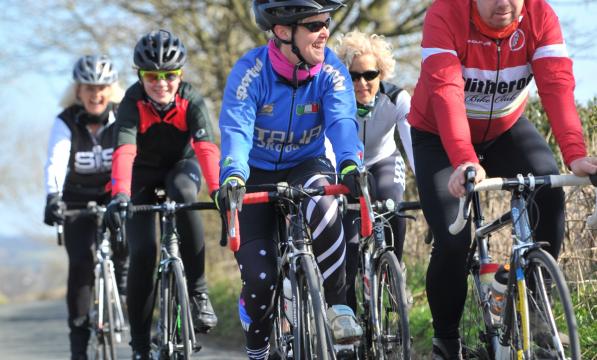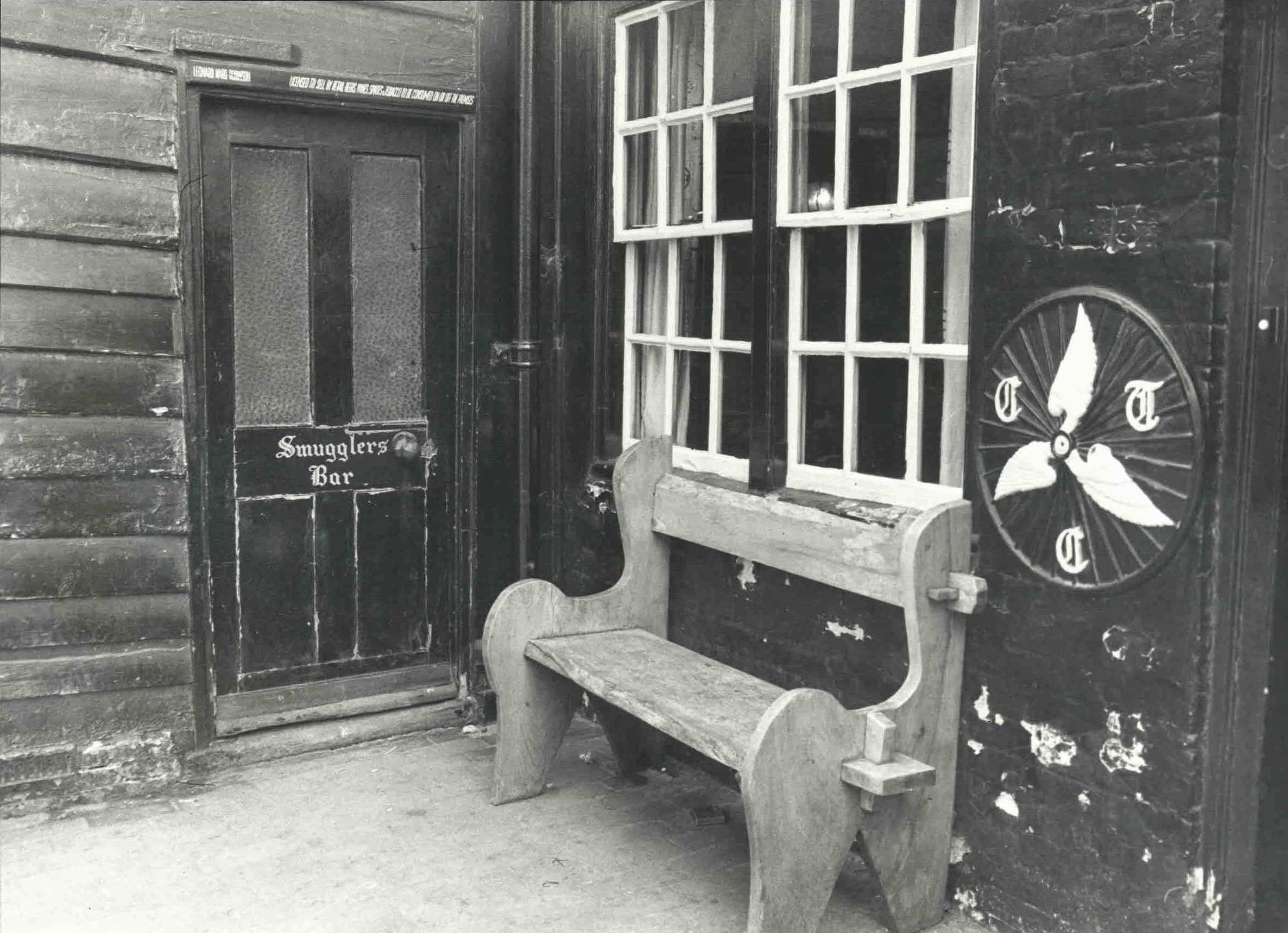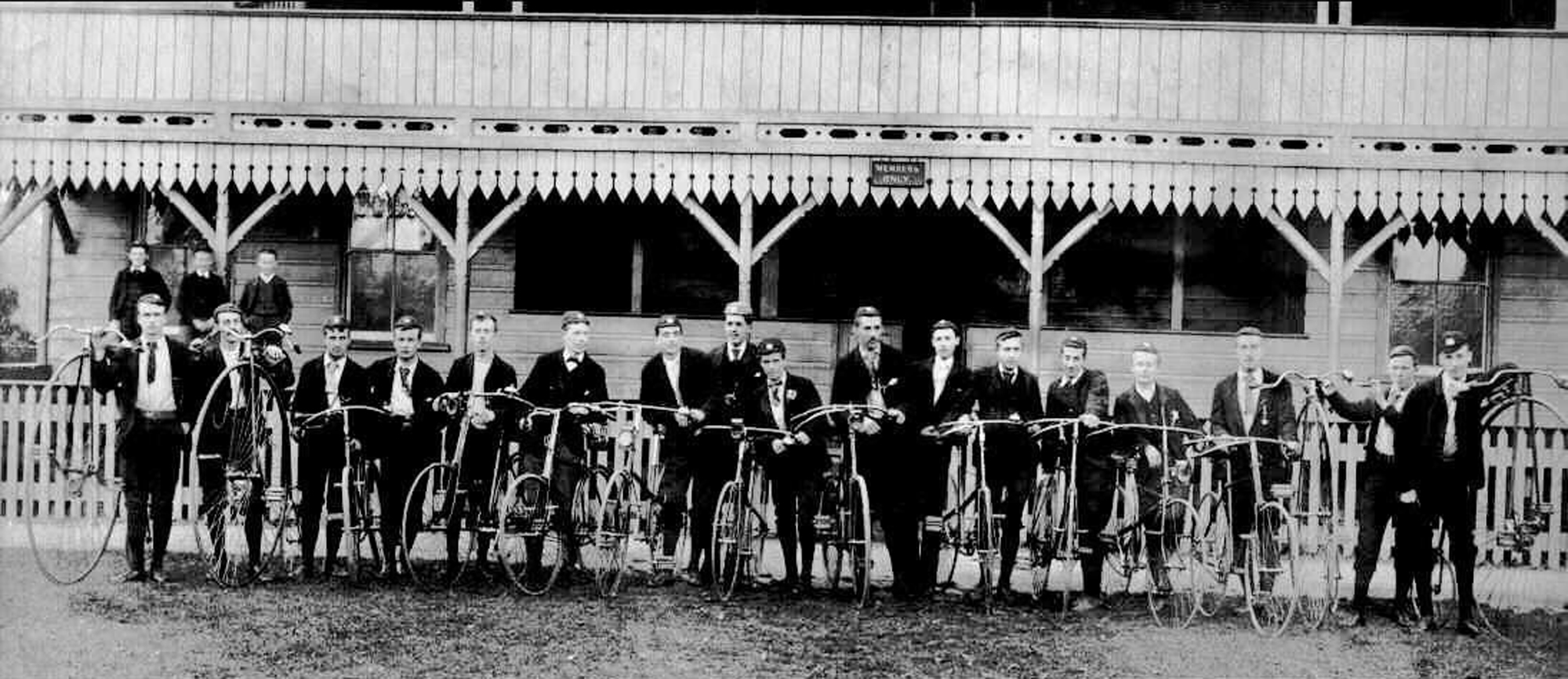Since 1878 - our journey from the Bicycle Touring Club to Cycling UK

Cycling UK has been promoting cycling and protecting cyclists since 5th August 1878. On that Bank Holiday Monday, thanks to the vision, verve and vigour of Edinburgh medical student Stanley Cotterell, the Bicycle Touring Club was formed in Harrogate. Five years later the organisation became the Cyclists’ Touring Club (CTC) to reflect the fact that a fair proportion of the first 10,000 members rode tricycles. Then, in April 2016 CTC became Cycling UK, to fully represent the fact it is the national cycling charity.
The oil-powered lamps have given way to LED lights, the CTC uniform of dark green serge jacket, knickerbockers and peaked helmet has morphed into figure-hugging Lycra (some would say for the worse), while cloth-backed maps and sepia-tint photographs have developed into GPS and GoPro.
Just as technology has advanced, so Cycling UK has adapted to the times. It’s been a process of evolution over 138 years - and yet nothing much has changed at all, really. The club’s principal stated objective from day one was: “To promote, assist and protect the use of bicycles, tricycles and other similar vehicles on the public roads.”
That aspiration is as true and relevant today as it was then. Cycling UK has always been the voice of the everyday cyclist, and many of the projects, campaigns and issues it tackles in 2017 are remarkably similar to those it dealt with in the late 19th and early 20th centuries.
Bike Week
Then
CTC was the driving force behind the first National Bicycle Week in 1923. The club helped organise a nationwide programme of rallies, fancy-dress parades, public meetings, massed club runs, race meetings, school lectures and BBC talks.
The great 'Ride A Bicycle' campaign included an 888-mile relay round England, with cyclists carrying a message on vellum from the Lord Mayor of London which was signed by 30 civic dignitaries en route.
The last day of the relay, 3 June, coincided with King George V’s 58th birthday. The day before, a CTC procession rode to Buckingham Palace conveying a message of congratulations to the club’s patron.
Now
94 years later, Cycling UK's Bike Week 2017 again spread the cycling word from 10-18 June, with the emphasis on getting people to ride to work.
Half-a-million people took part in more than 1,000 events to make the biggest nationwide cycling event in the UK another resounding success.
Bike Week demonstrates the social, health and environmental benefits of cycling, whether it’s for fun, as a means of getting to work or school, to get to the shops or just to visit friends.
Campaigning for cyclists
Then
Campaigning has been in our DNA from the start. It had to be, bearing in mind the amount of anti-cycling sentiment that has existed ever since the first boneshakers appeared on roads in 1867.
One of the greatest victories in CTC’s history came in 1888, when a skilfully-waged campaign led to the Local Government Act recognising cycles as ‘carriages’ with the right to use roads for the first time - legislation so important, it was dubbed the ‘Cyclists’ Magna Carta’.
Until then, downtrodden cyclists had suffered under unreasonable bylaws that differed from one local authority to the next. For example, in Southampton cyclists were “compelled to dismount if signalled by a horse rider or carriage driver”.
That all changed after Parliament agreed a motion proposed by Sir John Dorington, MP for Tewkesbury, Gloucestershire, on behalf of CTC. Sir John was a CTC member and his club colleagues bombarded MPs with letters calling for their support.
Now
With your help, we’ve been lobbying MPs ever since that landmark 1888 Act - never more so than last year, when politicians of all major parties debated funding for cycling at Westminster Hall.
Cycling UK vigorously campaigned for some of the Government’s vast £15 billion roads budget over the next five years to be reallocated to CWIS (Cycling and Walking Investment Strategy), which was set to receive a derisory £300 million.
Ahead of the Westminster Hall debate, Cycling UK set up an online action enabling members to email their local MP to persuade them to attend and speak up in support of investment for cycling. We also provided MPs with a briefing document and spoke to them on the day.
With your help, we will continue to campaign for at least £10 per head per year to be invested in cycling.
Cycle training
Then
Thousands of people up and down the country will still have their metal Cycling Proficiency Test badge tucked away in a drawer - possibly even Prince Charles, who passed in 1960 at the age of 12.
The proficiency test was the brainchild of CTC. At the 1938 AGM, Reginald Cairns Shaw, assistant editor of the CTC Gazette, proposed a motion calling for education authorities to introduce cycle instruction into the school curriculum - as cycling casualties had been rising.
The outbreak of World War Two meant it was 1947 before the Royal Society for the Prevention of Accidents introduced a scheme for training and testing children in cycling proficiency. CTC prepared the instruction manual, with seven children taking part in the pilot session on 7 October.
Now
Cycling UK helped co-ordinate a new look for Cycling Proficiency in the 21st Century - and its successor was born. In 2007, it was renamed Bikeability under the new National Standards for Cycle Training, which took into account the growing popularity of off-road cycling and mountain bikes.
More than 1.8 million young people have had formal cycle training so far and, just before Christmas 2015, the Government announced £50m for Bikeability over the next four years.
Cycling UK does all it can to encourage kids to cycle for the benefit of their health and the environment, holding after-school cycling sessions around the country and running such projects as Play On Pedals, which aims to teach all four-year-olds in Glasgow to cycle before they start primary school and is being rolled out nationally in Scotland.
Group riding
Then
One of CTC’s founding objectives in 1878 was “to provide companions for a tour from a list of members to be kept by the hon sec”. Before long, there were groups of club members riding together around the country.
Sometimes national events brought these groups together. Remembering the success of the great Relay Ride during the first National Bicycle Week 12 years earlier, CTC decided to repeat the event to mark King George V’s Silver Jubilee in 1935.
Teams of riders from 42 District Associations covered 2,250 miles in 15 days, travelling from the south coast as far north as Dundee, with excursions into Wales at Cardiff and Llandudno. There was also a 200-mile ride in Northern Ireland.
A message of congratulations for His Majesty, CTC’s patron, was carried on the relay and signed by nearly 100 mayors and provosts.
Now
Cycling UK's 130 Member Groups and around 60 informal groups put on 13,613 rides in 2015 - an average of 262 every week. There were 248 sportive and challenge rides around the UK and more than 1,000 off-road rides.
Cycling UK has more than 600 Affiliate Groups, 400 of which put on about 20,800 rides in 2015, involving 8,000 individual cyclists. And a staggering 1.5 million hours were contributed during the year by Cycling UK volunteers.
Touring holidays
Then
Those early cycling pioneers swiftly turned their attentions to touring abroad - and there were enormous benefits to being a CTC member.
The first ‘Continental Road Book’ was published in 1887, costing 10 shillings for three volumes and covering such destinations as Austria-Hungary and Servia, as Serbia was referred to at the time.
Two years later, a special foreign customs committee was set up and before long various countries waived the import tax for a ridden bicycle when crossing their border if you held a CTC membership card.
In the 1930s, the Cyclists’ Touring Club advertised an all-in tour for £3 10sh, staying at hotels recommended by cyclists.
Now
Formed in 2000, CTC Cycling Holidays sells an average of 1,200 holidays a year, mainly to Europe but also further afield, with a rate of 60% return bookings.
France - perhaps predictably - is the most popular foreign destination, but there are also around 12 long-haul tours each year to the likes of South-East Asia, India, Japan and China.
Cycling for all
Then
On 27 October 1898, CTC member Florence Wallace Pomeroy, Lady Harberton, was refused service at the Hautboy Hotel in Ockham, Surrey, because she was wearing ‘Rational Dress’ - baggy knickerbockers and a jacket - rather than the ankle-length, voluminous skirt that made cycling something of a hazardous occupation for women at the time.
Lady Harberton was told she could have lunch in an apartment off the public bar, which was occupied at the time by three men who were smoking and drinking.
CTC removed its Winged Wheel from the Hautboy and took the hotel’s landlady, Martha Sprague, to court for “wilfully and unlawfully neglecting and refusing to supply a traveller with victuals".
It took an all-male jury just 12 minutes to find Mrs Sprague not guilty, but the case hit the national headlines, made CTC a lot of friends, led to more women’s cycling groups, and was a milestone on the road to female emancipation.
Now
Cycling UK believes cycling is for everyone - of any age, ability or background. Inclusivity is the keyword.
Cycling UK members were among the hundreds of women who took part in the Tribute To Billie Ride throughout 2015, in memory of legendary distance cyclist Billie Fleming, who set a world one-year cycling record in 1938.
Our community cycle clubs around the country hold regular rides to encourage more women to cycle, including from the Asian community.
We also provide regular cycling opportunities around the country for the disabled and disadvantaged, helping people to overcome personal barriers to cycling.
Road justice
Then
One of the original objectives of the Bicycle Touring Club in 1878 was: “The protection, so far as funds permit, of members against unprovoked assaults on British highroads whilst riding bicycles.”
By December 1934, that philosophy resulted in the establishment of a Defence Fund, initially worth £500, “for the purpose of resisting the continued encroachment upon cyclists’ rights and the persecution that is spreading in so many directions”.
A resolution was also carried “condemning the scandalous conduct of coroners’ courts when considering fatal road accidents”.
Now
Cycling UK’s Cyclists’ Defence Fund raised £75,000 to bring a private prosecution against the driver of a car which hit Mick Mason from behind as he cycled on London’s Regent Street three years ago. Mick died 19 days after the incident but the police failed to press charges against the driver.
Daniel Squire, 18, was killed by a van, whose driver had failed to see him cycling along a straight road in Kent on a clear day. Yet a jury cleared the driver of all charges, even though he had been texting continuously until seconds before the collision. Daniel's devastated family are now donating money raised through fundraising to CTC's Road Justice campaign.
Improving access
Then
In 1885, Richmond Park and Regent’s Park in London were the first of several Royal Parks opened to cyclists as a result of CTC action.
According to the CTC Gazette: “It was confidently predicted by the anti-cycling brigade that such a step must be attended by disaster. The good sense of the great body of riders has, however, happily triumphed.”
In 1968, CTC helped enshrine in law - the new Countryside Act - the right to cycle on bridleways and long-distance cross-country routes.
Now
Throughout September 2015, we combined with Open MTB to run the joint Trails for Wales campaign, galvanising the support of more than 4,000 people from the off-road community and wider cycling industry.
The campaign called for open access to the Rights of Way network in Wales, as enjoyed by Scotland since 2003.
The Scottish economy has benefitted by £46.5 million a year thanks to increased mountain bike access. It is hoped Wales would enjoy similar success - and help pave the way for open access rights to be considered in England.
Bikes on trains
Then
From its inception, the Bicycle Touring Club was in conflict with the railways over charges for carrying cycles and their careful handling.
Astute negotiation did result in a 50% reduction in rates between 1878 and 1886, with the occasional concession for the cyclist as well as the cycle itself.
CTC even promoted a competition in 1896, with a prize of 20 guineas, for the best-designed luggage van suitable for taking cycles.
Now
Cyclists looked set to be treated as third-class passengers again in 2015 when Eurostar announced it would make them dismantle and box up their bikes to travel. But Cycling UK made sure that particular plan hit the buffers thanks to its ‘Zero Stars for Eurostar’ campaign.
Nearly 10,000 people protested through an online petition spearheaded by Cycling UK and ECF (the European Cyclists’ Federation), and we galvanised support from leading politicians on both sides of the Channel, which resulted in Eurostar doing a U-turn.
A welcome for cyclists
Then
Favourable rates for members were agreed with hotels and hostelries around the country before the first Christmas carols had even been sung in 1878 - and the first ‘Handbook and Guide’, listing club-friendly establishments, was published the following year.
CTC’s legendary Winged Wheel badge was adopted in 1886 and the following year giant plaques of the emblem started appearing on those inns and hotels recommended by the club, many of which can still be seen today.
The introduction of the new Winged Wheel badge represented a big change for CTC. But, as the Gazette of February 1886 reported: “Out of a Club of over 20,000, only two members have dissented in the remotest degree from the decision arrived at, while the remaining commentors vie with each other in eulogising the adoption of so satisfactory a step.”
Now
CTC’s Winged Wheel emblem was the ultimate accolade for a hotel owner, long before Michelin stars were being handed out.
But being made out of cast iron and two feet in diameter, it is a little cumbersome - which is why it has now been replaced by a much more manageable window sticker with the Cycling UK logo that states Cyclists Welcome. A searchable directory of cyclist-friendly accommodation (and more) is online.
So there you have it. Little has really changed. At the end of the day it’s you, alone or with friends, on road or off road, cycling in the open air and exploring the world with a spirit of freedom and adventure - just as it was 138 years ago.
We're still encouraging people to enjoy the gift of cycling and protecting your right to do it, as we have every day since 5 August 1878. We’ll continue to do so every day in the future… with the help and support of the people who count most: you, our members.


















